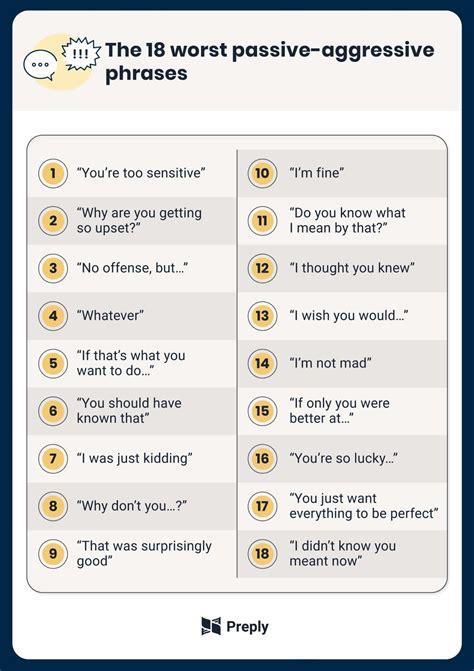
Passive-aggressive behavior, often subtle and indirect, can damage relationships and create toxic environments. Experts have identified key phrases that act as red flags, signaling this communication style. Recognizing these phrases can help individuals navigate interactions and address underlying issues more effectively.
Passive-aggressive communication, a masked form of hostility, manifests in indirect expressions of negative feelings. While seemingly harmless on the surface, these behaviors can erode trust and create misunderstandings. Psychologists and communication experts emphasize the importance of recognizing the patterns and addressing them constructively to foster healthier relationships. This article delves into thirteen tell-tale phrases that experts say may indicate someone is engaging in passive-aggressive behavior.
One common indicator is the phrase, “I was only joking.” According to Signe Whitson, LSW, a licensed social worker and author specializing in bullying and aggressive behavior, this phrase is often used to dismiss hurtful comments or actions. “When someone delivers a barb and then tries to soften the blow by saying they were ‘just joking,’ they are likely engaging in passive aggression,” Whitson explains. This deflection tactic avoids accountability and invalidates the other person’s feelings.
Another phrase to watch out for is “Fine.” While seemingly innocuous, in certain contexts, “fine” can be loaded with resentment. If delivered with a specific tone or body language, it can indicate suppressed anger or disagreement. As experts note, paying attention to nonverbal cues alongside verbal communication is crucial in identifying passive-aggressive behavior. A simple “Fine” in response to a request, delivered with a sigh and eye roll, speaks volumes.
The phrase “Whatever” also falls into the category of dismissive responses, indicating a lack of engagement or agreement without explicitly stating it. This type of response shuts down communication and leaves the other person feeling unheard. “Whatever” can be a particularly frustrating response to receive, as it offers no opportunity for dialogue or resolution.
Statements like “I’m not mad” (when clearly exhibiting anger) are also classic examples. This denial of feelings, coupled with contradictory behavior, creates confusion and undermines trust. The incongruence between words and actions is a hallmark of passive aggression. “The key to spotting this one is to look at the person’s behavior,” experts say.
Procrastination and deliberate inefficiency can also be passive-aggressive tactics. Phrases like “I forgot” or “I’ll get to it later” (without following through) are often used to avoid responsibility or express resentment indirectly. This behavior can be particularly damaging in professional settings, where it can lead to missed deadlines and project delays.
Another red flag is the use of backhanded compliments, such as “That’s good… for you.” These seemingly positive statements carry an underlying negative message, undermining the recipient’s accomplishments. These types of comments are often designed to subtly put the other person down, maintaining a sense of superiority.
Phrases like “I’m just being honest” can also be used to disguise critical or hurtful statements. While honesty is valued, using it as a justification for negativity can be a form of passive aggression. The intention behind the statement is key; is it genuinely meant to be helpful, or is it simply a way to deliver a veiled insult?
The phrase “You’re so sensitive” is often used to invalidate someone’s feelings and shift the blame. This tactic avoids addressing the real issue and puts the other person on the defensive. By labeling someone as “sensitive,” the person engaging in passive aggression avoids taking responsibility for their own behavior.
Another common phrase is “I didn’t realize you wanted it done that way.” This excuse is often used to avoid responsibility for mistakes or to express resentment towards being told what to do. It’s a way of saying, “I did it my way, and if you don’t like it, that’s your problem.”
Statements like “Since you’re so good at it, can you do it?” are also indicative of passive aggression. This phrase shifts responsibility onto someone else while subtly implying their own inadequacy. It’s a way of avoiding work while making the other person feel obligated to take on the task.
The phrase “Don’t worry about it” said with a dismissive tone can also be a sign. It suggests that the speaker doesn’t value the other person’s concerns or opinions. The tone and body language accompanying the phrase are crucial in determining its true meaning.
Another phrase to be aware of is “As I said before…” This phrase is frequently employed to subtly belittle or imply that someone wasn’t listening or is somehow less intelligent. Its intent is to make the recipient feel inadequate and less valued.
Finally, statements like “I thought you knew” are often used to avoid taking responsibility for not communicating clearly. This tactic places the blame on the other person for not being psychic or intuitive enough to understand unspoken expectations.
Recognizing these phrases is the first step in addressing passive-aggressive behavior. Experts recommend communicating assertively, setting boundaries, and addressing the underlying issues that are driving the behavior. Assertive communication involves expressing your needs and feelings clearly and respectfully, without resorting to aggression or passivity.
Setting boundaries is also crucial in dealing with passive-aggressive behavior. This involves clearly communicating what behavior is acceptable and what is not, and enforcing those boundaries consistently.
Addressing the underlying issues is essential for long-term change. Passive-aggressive behavior often stems from unresolved anger, fear of confrontation, or low self-esteem. Therapy or counseling can help individuals explore these issues and develop healthier coping mechanisms.
Furthermore, understanding the root causes of passive-aggressive behavior can foster empathy and more effective communication. Individuals exhibiting these behaviors may have learned them as coping mechanisms in childhood or past relationships. Recognizing this can shift the focus from blame to understanding and facilitate more constructive dialogue.
For example, someone who grew up in a household where expressing anger was forbidden might develop passive-aggressive tendencies as a way to indirectly communicate their displeasure. Similarly, someone who has been repeatedly criticized or belittled might resort to passive aggression as a defense mechanism.
In professional settings, passive-aggressive behavior can create a toxic work environment, leading to decreased productivity, low morale, and increased employee turnover. Managers and HR professionals should be trained to recognize and address these behaviors effectively. This can involve providing clear feedback, setting expectations, and offering support to employees who are struggling to communicate assertively.
Conflict resolution training can also be beneficial in helping employees learn how to address disagreements constructively. This type of training can teach employees how to express their needs and feelings in a respectful manner, listen actively to others, and find mutually agreeable solutions.
Ultimately, addressing passive-aggressive behavior requires a combination of awareness, communication, and empathy. By recognizing the tell-tale phrases, understanding the underlying issues, and communicating assertively, individuals can create healthier relationships and foster more productive environments. It’s a process that requires patience, understanding, and a commitment to personal growth.
The long-term impact of unchecked passive-aggression can be severe. Relationships can crumble under the weight of constant miscommunication and resentment. Individuals may experience increased stress, anxiety, and depression. In the workplace, productivity can suffer, and careers can be derailed. Therefore, addressing these behaviors proactively is crucial for both personal and professional well-being.
Learning to identify these patterns in ourselves is equally important. Often, individuals engage in passive-aggressive behavior without realizing it. Self-reflection and a willingness to examine our own communication styles are essential for personal growth. Seeking feedback from trusted friends, family members, or colleagues can also provide valuable insights.
In addition to the phrases mentioned above, certain nonverbal cues can also indicate passive aggression. These include eye-rolling, sighing, sarcasm, and a general lack of enthusiasm. Paying attention to these nonverbal signals can provide further clues about someone’s true feelings.
The digital age has also provided new avenues for passive-aggressive behavior. Social media platforms, email, and text messaging can all be used to deliver veiled insults, make indirect criticisms, or avoid direct communication. For example, a sarcastic comment on a social media post or a delayed response to an email can be subtle forms of passive aggression.
Furthermore, the anonymity afforded by the internet can embolden individuals to engage in more aggressive behaviors than they might otherwise. Online forums and comment sections often become breeding grounds for passive-aggressive remarks and personal attacks.
Therefore, it’s important to be mindful of our own online communication and to avoid engaging in behaviors that could be interpreted as passive-aggressive. This includes thinking carefully before posting or sending messages, being respectful of others’ opinions, and avoiding personal attacks.
In conclusion, recognizing the signs of passive-aggressive behavior is crucial for maintaining healthy relationships and creating positive environments. By being aware of the tell-tale phrases, understanding the underlying issues, and communicating assertively, individuals can navigate these challenges effectively and foster more constructive communication. The journey towards healthier communication requires self-awareness, empathy, and a commitment to personal growth. It’s a journey worth undertaking for the sake of our relationships, our careers, and our overall well-being. The subtle nuances of language, coupled with the importance of understanding nonverbal cues, make mastering effective communication a lifelong endeavor. Recognizing and addressing passive-aggressive tendencies, both in ourselves and in others, is a significant step towards fostering genuine and transparent connections. This awareness promotes a culture of open dialogue and mutual respect, leading to more fulfilling and harmonious interactions in all aspects of life. The ability to navigate these complex communication dynamics is not merely a skill; it’s an investment in our personal and professional success. By cultivating empathy and practicing assertive communication, we empower ourselves to build stronger relationships, resolve conflicts effectively, and create environments where everyone feels valued and heard. This proactive approach to communication not only enhances individual well-being but also contributes to a more positive and productive society as a whole.
Frequently Asked Questions (FAQ) About Passive-Aggressive Behavior
1. What exactly is passive-aggressive behavior?
Passive-aggressive behavior is a communication style characterized by indirect expressions of negative feelings, resentment, or hostility. Instead of expressing these feelings directly, individuals may use subtle tactics such as procrastination, sarcasm, backhanded compliments, or denial of emotions to express their dissatisfaction. According to experts, it’s a way of expressing anger or disagreement without being openly confrontational. This often stems from a fear of conflict or a difficulty in expressing emotions directly. The key is the discrepancy between what is said and what is actually meant or felt, often accompanied by nonverbal cues that betray the underlying negativity.
2. What are some common signs or red flags that someone is being passive-aggressive?
Several key phrases and behaviors can indicate passive-aggression. These include: frequently saying “I was only joking” after making a hurtful remark, using “Fine” with a dismissive tone, saying “Whatever” to shut down communication, denying anger (“I’m not mad”) when clearly exhibiting it, procrastinating or being deliberately inefficient, giving backhanded compliments (“That’s good… for you”), using “I’m just being honest” as an excuse for criticism, invalidating someone’s feelings (“You’re so sensitive”), making excuses like “I didn’t realize you wanted it done that way,” shifting responsibility with phrases like “Since you’re so good at it, can you do it?”, dismissing concerns with “Don’t worry about it” (said insincerely), subtly belittling with “As I said before…”, and avoiding responsibility with “I thought you knew.” Nonverbal cues like eye-rolling, sighing, and sarcasm are also strong indicators.
3. What are the potential causes of passive-aggressive behavior?
Passive-aggressive behavior often stems from a combination of factors, including:
- Learned Behavior: Individuals may have learned passive-aggressive communication patterns in childhood, often in environments where direct expression of anger or disagreement was discouraged or punished.
- Fear of Confrontation: Some people fear direct conflict and may resort to passive aggression as a way to avoid it.
- Low Self-Esteem: Feelings of inadequacy or insecurity can lead individuals to express resentment or hostility indirectly.
- Unresolved Anger: Suppressed anger or resentment can manifest as passive-aggressive behavior.
- Control Issues: Passive aggression can be a way of exerting control in situations where individuals feel powerless.
- Past Trauma: Traumatic experiences can lead to difficulties in expressing emotions directly and may contribute to passive-aggressive tendencies.
4. How can I effectively respond to someone who is being passive-aggressive?
Responding to passive-aggression requires a combination of assertiveness, empathy, and boundary-setting. Here are some strategies:
- Acknowledge the behavior: Gently point out the discrepancy between their words and actions. For example, “I hear you saying you’re not upset, but I’m sensing some frustration. Is there something you’d like to talk about?”
- Stay Calm: Avoid reacting defensively or emotionally. Maintaining a calm demeanor can help de-escalate the situation.
- Set Boundaries: Clearly communicate what behavior is acceptable and what is not. For example, “I’m happy to discuss this with you, but I’m not comfortable with sarcasm.”
- Focus on the Issue: Don’t get sidetracked by the indirect behavior. Try to address the underlying issue that the person is avoiding.
- Use “I” Statements: Express your feelings and needs using “I” statements, such as “I feel frustrated when I don’t receive clear communication.”
- Don’t Take it Personally: Remember that passive-aggressive behavior is often a reflection of the other person’s internal struggles, not necessarily a reflection of you.
- Consider Professional Help: If the behavior is persistent or causing significant distress, encourage the person to seek therapy or counseling.
5. How can I stop myself from being passive-aggressive?
Becoming aware of your own passive-aggressive tendencies is the first step towards change. Here are some strategies to help you communicate more directly and assertively:
- Self-Reflection: Pay attention to your own thoughts, feelings, and behaviors. Ask yourself why you might be resorting to indirect communication.
- Identify Triggers: What situations or people tend to trigger your passive-aggressive behavior?
- Practice Direct Communication: Make a conscious effort to express your needs and feelings clearly and respectfully. Use “I” statements to communicate your perspective without blaming others.
- Learn to Express Anger Healthily: Find healthy ways to express anger, such as exercise, journaling, or talking to a trusted friend or therapist.
- Challenge Negative Thoughts: Identify and challenge negative thought patterns that may be contributing to your passive-aggressive behavior.
- Seek Feedback: Ask trusted friends, family members, or colleagues for honest feedback about your communication style.
- Therapy or Counseling: Consider seeking professional help to explore the underlying issues that may be driving your passive-aggressive behavior. A therapist can provide tools and strategies for developing healthier communication patterns and coping mechanisms.
- Practice Empathy: Try to understand the perspectives of others and consider how your behavior might be affecting them.
- Be Assertive, Not Aggressive: Assertiveness involves expressing your needs and feelings respectfully, while aggression involves violating the rights of others. Learn to distinguish between the two and strive for assertive communication.
- Forgive Yourself: It’s okay to make mistakes. If you slip up and engage in passive-aggressive behavior, forgive yourself and commit to doing better in the future. The journey to healthier communication is a process, and it takes time and effort.









